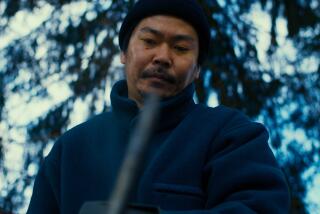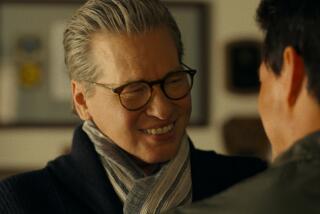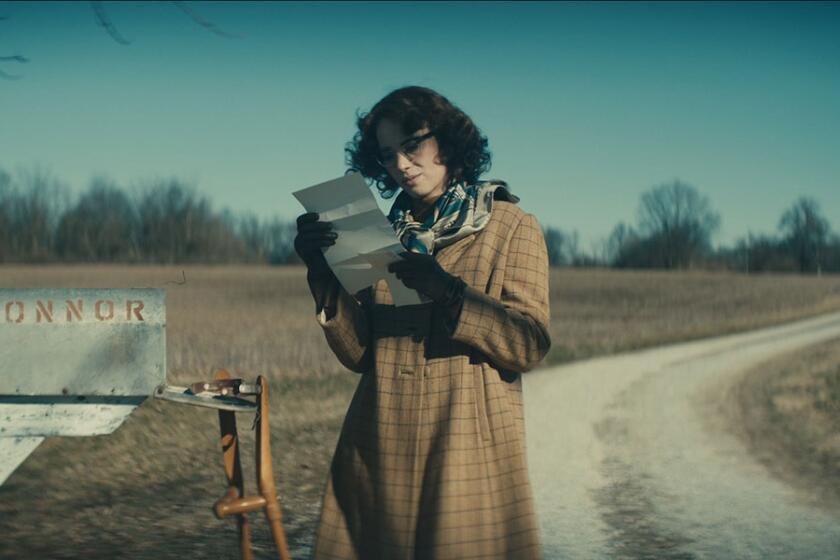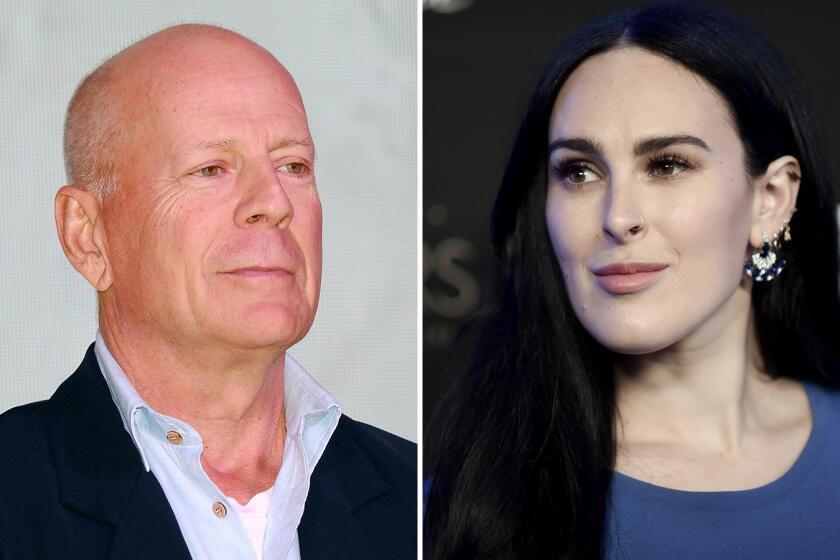Empathy for the Bedeviled
Director Guillermo del Toro is one of those lucky people whose childhood passion has become their life’s work.
Fascinated by the horror genre since he was a child growing up in Guadalajara, Mexico, he has developed during the past decade into one of the most innovative horror directors in contemporary cinema. At the 1993 Cannes International Film Festival, he won the critics’ prize for his vampire thriller “Cronos,” and he followed that up with his first American production, the sci-fi thriller “Mimic.” His latest, “The Devil’s Backbone,” a Spanish-language ghost story set in an orphanage, opens Friday.
A big teddy bear of a man, Del Toro, 37, says he was attracted to horror films not just for the visceral experience, but because he felt that they spoke to him. “Part of me felt even at a young age spiritually different,” Del Toro says during a recent interview at his office in Burbank, where he is busy in post-production on his next release, the vampire action-thriller “Blade 2.”
“I felt at the age of 7 or 8 or even earlier I didn’t really belong with the other kids that perfectly. I felt like an outsider. The horror genre seemed to show me other outcasts I could sympathize with. That is why I can’t help but love the ghost in ‘The Devil’s Backbone,’ why I loved the bugs in ‘Mimic’ and why I love the vampires in ‘Blade 2.’ I am in favor of the monster.”
“What is a ghost? An emotion, a terrible moment condemned to repeat itself over and over? An instant of pain perhaps? Something dead which appears at times alive. A sentiment suspended in time ... like a blurry photograph ... like an insect trapped in amber.”
These words, spoken by an elderly professor, Casares (Federico Luppi), open “The Devil’s Backbone,” which is set at the desolate Santa Lucia School during the last days of the Spanish Civil War of the ‘30s. The forbidding stone building shelters orphans of the Republican militia and other children who lost their parents in the conflict.
The latest arrival is 10-year-old Carlos (Fernando Tielve), who is immediately confronted by the bully Jaime (Inigo Garces), the biggest and oldest of the orphans. Other residents include headmistress Carmen (Marisa Paredes), the widow of a leftist poet. She is having a secret affair with greedy young caretaker Jacinto (Eduardo Noriega), who harbors a great hatred for the school and the teachers who raised him.
Carlos quickly learns about the deep dark secrets of the school and the ghost that can be seen walking the halls with blood oozing from his skull--the ghost of Santi (Junio Valverde), a student who was brutally murdered and thrown into a pool in the basement. Santi’s pale ghost keeps appearing to Carlos, warning that death will await those who remain at the school.
As with producer Val Lewton’s ‘40s atmospheric horror films, such as “Cat People” and “I Walked With a Zombie,” and Robert Wise’s 1963 classic ghost story “The Haunting,” the thrills in “Devil’s Backbone” are subtle, emphasizing fear and suspense rather than gore.
“Fear is anticipation,” says Del Toro, who studied special effects and makeup with the legendary makeup artist Dick Smith (“Little Big Man,” the first two “Godfather” movies, among others) before he did “Cronos,” “the capacity of an audience to feel anticipation for something. The other word would be dread. I understand when to show something and when not to show something.”
In “Devil’s Backbone,” however, he broke one of his own rules. “But I break it on purpose,” Del Toro explains, chuckling huskily. “The more you show something, the less scary it is. I tried to do that with the ghost in the movie, not only showing it more and more often, but showing it in different lights until we arrive at the moment where basically he is a kid standing in daylight. You should, through the course of the movie, stop fearing the dead and start fearing the living.”
Del Toro wrote “The Devil’s Backbone” 16 years ago. “I wanted to do this before ‘Cronos.’ I always wanted to talk of my childhood with a tale that was not directly related to my childhood. Without becoming metaphoric. There is a really violent universe with children. We try to sort of shelter and isolate childhood by idealizing it in the movies or neglecting to deal with childhood and violence. One of the most horrifying moments in my life was when I was probably 8 or 9 to 10, and I knew I dreaded going to school because I knew the degree they would torture my soul and the degree they would torture my body. I learned to defend myself.”
Not everybody at his school was so adept. Del Toro recalls one particularly vicious fight: “I saw kids fighting with each other with wood boards and one of them had a rusty nail. One of the kids tried to stop the other kid’s board and his hand was perforated by the nail. There was all of this blood. We all ran away.”
Del Toro wrote the script when he was in college. “It is the story with which I graduated from screenwriting school,” he says. He perfected the script at several workshops, trying to find the right tone. “It was so difficult to balance the war story with all the personal stories and the ghost story together. I felt this was a movie that those three stories--the personal story, the ghost story and the war story--would illuminate each other in a different light than if I filmed them separately.”
Pedro Almodovar’s brother, Agustin, served as executive producer of the film. The Almodovars met Del Toro in 1994 at the Miami Film Festival. “I was at the area of the pool in a little terrace and I heard a voice saying, ‘Are you Guillermo Del Toro?’” he recalls. “I turned around and it was Pedro Almodovar. He said, ‘I just saw “Cronos,” and I want to produce your next film.’ Three meetings later--those meetings happened in a course of three or four years--we were in pre-production. He was direct and simple and absolutely loyal to his work.”
In the interim, Del Toro did “Mimic” for Dimension and moved from Mexico to Texas. “Finally, I think that in a very odd way, the economical returns that ‘Mimic’ made all through the world made ‘The Devil’s Backbone’ financially possible,” Del Toro says. “All of a sudden, I found my value in the market bigger than when I did ‘Cronos.’”
Agustin Almodovar observes: “Pedro and I are very attracted to directors who have very personal work. Guillermo is a very atypical director of horror films. It is not easy to make that kind of [subtle] movies because you don’t use the easy tricks of effects. You have to rely on your narrative pulse and your creativity and your capacity to create the tension naturally.”
Del Toro set “Devil’s Backbone” during a war because, he says, “in the best of circumstances, if you talk about evil, it is nicer if you can actually show evil as a Chinese box puzzle where you show one small evil, a bigger evil and then a larger evil or a concept,” he says.
“What I like in ‘Devil’s Backbone’ is I wanted very much to show how perverse and pervasive the influence of war can be even if you are removed geographically from the battlefield,” he adds. “After September 11, every single act of our life is permeated by war, and we have had only one incident--a terrible one. Imagine how the constant living with war on a daily basis permeates the acts of everyone. I wanted to show that the orphanage was removed from the war but ends up in a way mimicking what is going on outside.”
The orphanage becomes one of the film’s main characters. On the outside it is disintegrating, much like the building in Poe’s “The Fall of the House of Usher.” But inside, there is still some semblance of former elegance. “There are places like this in countries like Mexico or Spain where you travel through the desert or jungles for hours and all of a sudden you found a palace. The inside we modeled after institutional buildings of the era. We fused two styles. The outside of the building is romantic--the building as a whole looks like it had been put together through the centuries. I wanted to give you sense of a building that had been composited over the years.”
The entrance was modeled after a piece of architecture from one of his favorite films, 1966’s “Kill, Baby ... Kill,” directed by Mario Bava. “I love it,” he says. “It looks like two little eyes with a huge mouth.”
Del Toro’s visual vocabulary also impressed Peter Frankfurt, who says, “I am just patting myself on the back that we got him” for the “Blade” sequel. “I had seen ‘Cronos’ and was very impressed, and we actually talked about him for the first ‘Blade’ and it didn’t happen.”
Frankfurt, who served as executive producer on both films, got to know Del Toro when his design company did the main title sequence to “Mimic.” “I was very impressed with the filmmaking in ‘Mimic,’ though I wasn’t 100% crazy about the movie. I didn’t think the movie lived up to the level it [should have], but it sort of reinforced my feelings that Guillermo is a major talent.”
He describes Del Toro as a “warm, lovely guy” who has a “very, very strong will. He has all the necessary conditions to be an effective conductor. He knows what he wants and what he needs to do to get it done. He is a genuine filmmaker.
“He has a wonderful visual style, but it is not just camera angles and production design. He understands the story very well and the character and nuance and tone and pace. I would work with him again in a heartbeat.”
In a perfect world, Del Toro would like to continue to move between the independent and big-budget Hollywood worlds. “I enjoy the freedom of [independent films] and then I enjoy the rigors of being in a Hollywood production,” he says. “One complements the other really well.”
More to Read
Only good movies
Get the Indie Focus newsletter, Mark Olsen's weekly guide to the world of cinema.
You may occasionally receive promotional content from the Los Angeles Times.







